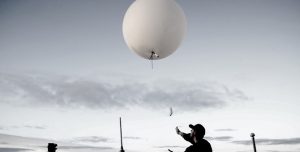
Near Space: India Should Move in Fast

Near Space; that portion of the atmosphere between the stratosphere and the mesosphere, typically between 20 and 100 kilometres above the Earth’s surface. While it is not technically outer Space, near Space offers a unique environment that has captured the attention of scientists, hobbyists, and government agencies alike. There is no international consensus governing the use of “near space”. Nations are generally understood to have control over their air space of up to 60,000 feet. And various treaties exist with no sovereign claims above 330,000 feet (space). Near-Space is neither governed by a treaty nor is it subject to control by the nation below.
While a handful of countries have claimed heights between 60,000 feet and space, an expanse often cited as “near space,” those claims aren’t recognised by international law. However, the lack of international agreements has not prevented nations from beginning to make claims. For example, New Zealand became the first country in 2017 to require oversight of such high altitudes in its space law. Other countries, including the UAE, have followed suit, claiming roughly 262,000 feet for managing high altitudes. But other countries haven’t accepted the UAE’s claim in those cases.

Near Space came to larger attention as a Chinese balloon with electronic sensors and solar panels strayed into US airspace from the Pacific coast and traversed across the continent. The USAF finally shot down the balloon on the Atlantic coastline on February 04. Speculations/ allegations that it was a surveillance balloon of the PLA and protestations that it was just a weather balloon flew back and forth. This event was followed quickly by three more balloons shot down by the USAF between 09 -12 February. These events dominated news headlines not only in the US but in other nations as well. The US president finally brought the media frenzy to a halt admitting that the last three balloons were not surveillance balloons but more likely to be commercial/ hobbyist balloons.
Surveillance balloons have a storied history dating back to the early days of aviation. In the late 18th century, entrepreneurial brothers Joseph-Michel and Jacques-Etienne Montgolfier from France developed a working balloon. In 1783, the first recorded human ascent was in a piloted lighter-than-air craft. The Montgolfiers were originally in the paper business, and the new invention proved extremely useful in map-making and providing publicity that could only aid profits. The French Revolution brought the first recorded use of balloons for military purposes, primarily reconnoitering and tracking enemy operations.
The US Civil War of 1861 to 1865 significantly expanded balloons for military missions. Although President Lincoln created the Union Army Balloon Corps in 1861, opposition from traditional officers forced the Corps to disband two years later. Balloons were used for offence and defence in World War I and II. They were a focus of planning between the wars but quickly became marginal with the advent of aeroplanes. Modern surveillance balloons are vastly different from their historical counterparts. They are much larger and more sophisticated than before, with advanced sensors and imaging equipment that allow them to gather high-resolution images and other data from great distances. In addition, they can often remain aloft for weeks or even months, making them a powerful and cheaper tool for long-term surveillance and reconnaissance operations.

In recent years, one of the most high-profile examples of near-space surveillance balloons is the JLENS system, which stands for Joint Land Attack Cruise Missile Defence Elevated Netted Sensor System. JLENS is a pair of tethered aerostats that can be deployed to altitudes of up to 10,000 feet, where they can stay aloft for up to 30 days. Google’s Project Loon uses a network of high-altitude balloons to provide internet access to remote and underserved areas around the world. These balloons, which can stay aloft for up to six months at a time, are equipped with specialised radios that allow them to provide internet connectivity to users on the ground below.
Similarly, World View Enterprises is a company that specialises in high-altitude balloon flights for research, commercial, and educational purposes. The company’s Stratollite balloons can stay aloft for up to six months and carry payloads of up to 100 kilograms to altitudes up to 30 kilometres above the Earth’s surface. The Stratollite has two balloons, the upper one filled with helium that provides lift and the other with pressurised air, which functions as a steering system. A condenser in the Stratollite sucks in the air in the upper atmosphere and pumps it into the second “super-pressure” balloon. The pressurised air is denser than the helium, so the super-pressure balloon acts as a weight. Steering is achieved by lowering the Stratollite’s altitude, by increasing the pressure, and vice versa, to climb. Depending on the altitude, winds move in different directions and speeds, so Stratollite’s controllers can steer it by altering its altitude.

Other nations, including the Chinese, have noted the domain’s potential. In a July 05, 2011, article in the PLA Daily titled Near Space – “A Strategic Asset That Ought Not to be Neglected” by Zhang Dongjiang; a senior researcher at the Chinese Academy of Military Sciences. While discussing the potential applications of Near-Space, it noted that it lacks the disturbances such as thunder, lightning and turbulence, yet is cheaper and easier to access than the altitudes where satellites can remain in orbit. Thus, holding superb prospects & potential for intelligence collection, reconnaissance & surveillance, air & ground warfare and securing communication. Zhang suggested that near-space can be exploited with hypersonic cruise vehicles and sub-orbital vehicles. In 2015 images were published in the military pages of Global Times of two small-scale stratospheric vehicles identified as KF13 and KF16. These were developed by the Opto-Electronics Engineering Institute of Beijing Aeronautics and Aerospace University, China’s leading aeronautical and aerospace research university. As per open source reports, Chinese state-owned corporation; China Aerospace Science and Industry Corporation (CASIC) has a full-fledged near-space program to produce very high-altitude UAV and hypersonic vehicles to wage combat near Space. In September 2016, Chinese official media reported that Project Tengyun, initiated by CASIC, was expected to be ready for a test flight in 2030.

It is clear that near-space is a domain with military and intelligence potential that India cannot ignore. India has to develop the requisite offensive and defensive elements best suited to exploit the advantages of the domain. Indian air defence radars must be upgraded to monitor slow-moving targets at this altitude. The fledgling space command has to come up with the requisite incentives to attract our entrepreneurial talent to exploit this opportunity. It also has clear civilian applications, making it an attractive military-civilian fusion that will attract risk capital.
Disclaimer
The opinions expressed in this article are the author’s own and do not reflect the views of Chanakya Forum. All information provided in this article including timeliness, completeness, accuracy, suitability or validity of information referenced therein, is the sole responsibility of the author. www.chanakyaforum.com does not assume any responsibility for the same.
Chanakya Forum is now on . Click here to join our channel (@ChanakyaForum) and stay updated with the latest headlines and articles.
Important
We work round the clock to bring you the finest articles and updates from around the world. There is a team that works tirelessly to ensure that you have a seamless reading experience. But all this costs money. Please support us so that we keep doing what we do best. Happy Reading
Support Us





















POST COMMENTS (1)
Yashraj Randad